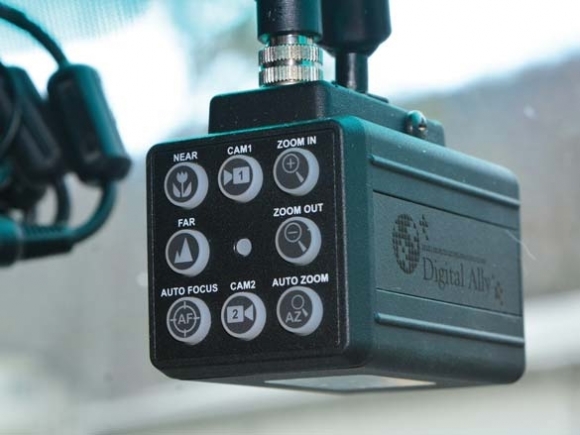The tools of truth

As the digital revolution proceeds unabated and technology exponentially shrinks in size and cost, law enforcement agencies have more tools in and on their trunks than ever before.
But with those tools, specifically dash-mounted or body-worn cameras, come controversies.
Orwellian conspiracy theories and concerns over public access to recordings from these devices haven’t slowed camera implementation, but costs have, leaving many rural departments fighting to find funding for what some — but not all — hail as a tremendous step forward in public safety and crime-fighting technology.
“It’s another tool for us to use to find the truth,” said Waynesville Police Chief Bill Hollingsed, who added that judges and juries find particular value in video evidence.
Worth a thousand words
Mounted on the dashboard or ceiling of a growing number of law enforcement vehicles is a small, boxy black plastic camera; when the blue lights come on, the camera starts recording.
Related Items
Except it’s been “recording” — cameras come equipped with a 30-second buffer, so when the lights go on, footage from the previous 30 seconds is added to the file.
A belt-mounted microphone allows officers to record verbal interactions once they’re out of the patrol car, and when they return, they manually stop the recording, give it an appropriate label like ‘DWI’ or ‘traffic stop’ and continue on their way.
Similar procedures are used for body-mounted cameras; the data is then either physically or wirelessly uploaded to a storage site, and used primarily to help police build cases against suspects.
“They feel like that is much better evidence than verbal testimony,” said Hollingsed, referring to judges and juries. “They want to see something visual. So the in-car cameras have been a very good tool and resource for us.”
But these videos aren’t just good for prosecutors — they’re good for police officers as well.
“I think officers have found that it has kept them out of trouble. Every time we’ve had a complaint involving an officer where they’ve been on video, the video has exonerated the officer,” he said. “If there was ever question, that camera told the story.”
The stories the cameras tell can be disturbing, but they are an essential piece of any police encounter.
In 2016 Keith Lamont Scott was shot and killed by police in Charlotte. Family members claimed Scott was reading a book in his car and was unarmed, but police thought otherwise.
After Scott ignored repeated orders to drop his weapon, he was shot by officer Brentley Vinson. Mecklenburg District Attorney Andrew Murray later said Vinson had acted within the law.
In the Scott case, two recordings — a body cam and dash cam — were used to shed light on what had transpired; a firearm was found at the scene, a book was not.
Similar incidents back in the 1990s are what led to the U.S. Department of Justice’s Office of Community Oriented Policing Services (COPS) to create the In-Car Camera Incentive Program, which began to dispense federal aid to state police to purchase and implement dashcams in 2000.
North Carolina was somewhat of an early adopter and began cam use in the 1990s; by 2004, only three states didn’t yet have them.
Before the program, only about 10 percent of state police highway patrol cars had cameras. Today, thanks in part to a three-year, $75-million U.S. Department of Justice grant offering beginning in 2015, more than 70 percent do.
“We want the public to have full confidence and trust in the Waynesville Police Department,” said Hollingsed. “What we have found is that as complaints come in they may sound horrific, but as you go back and watch the video you say, ‘That’s not what happened.’ Whether we’re right or wrong, that helps us aid in the prosecution of the case. The video camera will help us find the truth.”
The right to no
While nominally straightforward, the use of cameras — as well as microphones — by law enforcement has led to the thorny issue of who should have access to the recordings.
In North Carolina, the General Statute 132-1.4A governs law enforcement agency recordings and sets out several classes of people entitled to several levels of access.
 The process starts with a written request to the agency head, who may — but not “shall” — disclose but not release recordings to any person whose image or voice is in the recording, or that person’s designee or legal guardian.
The process starts with a written request to the agency head, who may — but not “shall” — disclose but not release recordings to any person whose image or voice is in the recording, or that person’s designee or legal guardian.
Disclosure is defined by the statute as “to make a recording available for viewing or listening,” and often occurs when people who are uniquely tied to the recordings ask to see relevant portions thereof.
Release, however, is defined as providing an actual copy of the recording and can be achieved only through court order. It is usually undertaken by someone not in the video, like members of the media, who have to prove that there is some sort of compelling public interest in the recording.
“People are interested in the conduct of public officials working in the public interest,” said Jeff Welty, Associate Professor of Public Law and Government and the Director of the North Carolina Judicial College. “People are interested when body or dash cams show law enforcement interacting with the public.”
Prior to the fall of 2016, North Carolina laws governing the distribution of audio and video recordings were considered vague and inadequate by critics, especially as to whether and when footage could be released by agencies.
Some departments held that recordings were public record, while some classified them as records of criminal investigations or personnel records, which are exempt from public disclosure.
Additionally, if a release request was denied, there was no clear direction as to which court should hear a request, or what set of standards that court would apply.
Since GS 132-1.4A was enacted last October, better definitions of “release” and “disclose” were added, as were standards for Superior Courts to evaluate, Welty said.
Now, departments can release recordings of their own accord only after obtaining a court order.
Petitioners unrelated to the case but seeking the release of recordings must also obtain a court order, after paying a filing fee of approximately $200 — which is seen by some as an unduly high barrier to smaller media outlets performing investigative work and ordinary public citizens with an interest in public affairs.
“Cams have the great potential to promote transparency and accountability and improve trust between law enforcement and the community,” said Mike Meno, communications director for the ACLU of North Carolina. “But that can only be the case if we have laws that ensure some level of public access.”
Meno said that the ACLU has raised concerns and spoken out on the limits of public access, including the cost of going to court to obtain recordings.
“Obviously there are privacy interests, but as a general rule, that should be the decision of the person in the video,” he said.
Nevertheless, right-to-know advocates now have at least some guidance on what can be released and under what circumstances it can be released.
“We try to balance that with the right of privacy of the public,” said Hollingsed. “And these body cams, they’re difficult sometimes to walk that fine line. Let’s say you’re the victim of a crime — you’re the victim of domestic violence — and we are in your home. Do you want that on the news?”
‘Infrared x-ray Superman vision’
Long-held fears of American society adopting the universal government surveillance depicted in George Orwell’s 1949 novel 1984 seem to have waned over the past two decades.
Indeed, most people give implied or explicit consent to be recorded by law enforcement agencies, private businesses, smartphone-wielding passersby and even drone aircraft on a daily basis.
Reasonable expectations for privacy outside the home are likely lower these days, but those fears have taken on a new tenor as technology continues to deliver more and more video to more and more people.
Some legislators — both in North Carolina and across the country — have called for the Robocop-esque use of augmented reality cameras that can record in night vision or infrared.
That idea doesn’t have a lot of support from law enforcement.
“We are adamantly opposed to that,” said Hollingsed.
While it could help with the visual identification of concealed suspects or concealed weapons or even help illuminate what, exactly, transpired during a midnight warehouse rave, officers don’t see the video in real time, making it of little use in cases like Keith Lamont Scott’s.
“Understand that with the decisions that are made in a split second on the street, when you’re judged on that it needs to be judged on the same criteria that the officers on the street have, not through infrared x-ray Superman vision. When they pull out that cell phone,” Hollingsed said, quickly brandishing his from just out of view and pointing it menacingly like a weapon, “we want the public to see what the officer saw and we want the courts to see what the officers saw — not what the technology saw.”
Another, more far-fetched imagining is that extensive use of recordings by law enforcement agencies — more than a third of the nation’s 18,000 police departments have or are testing recording equipment today — could lead to sinister applications, like the creation of an imagery database used to generate a profiling matrix capable of identifying, say, protestors in a crowd or clients to certain businesses.
While it seems implausible, it’s certainly not impossible, given the rapid technological advances that have spawned law enforcement gadgetry that cops hammering out reports on typewriters in the 1970s probably couldn’t have foreseen.
But a major barrier to the misuse — and even the legitimate use — of recordings still remains.
“By far, the most expensive part of a video camera program is the storage,” Hollingsed said.
Privacy and prosecutions both come at a price, borne ultimately by taxpayers. Dashboard cameras can run anywhere from a few hundred to a few thousand dollars apiece, so outfitting a department of several dozen — or several hundred — officers means finding the money.
Even worse, once the cameras are purchased and implemented, there’s the recurring storage cost that’s turned out to be a disaster for some departments.
An Associated Press story last fall focused on the town of Clarksville, Indiana’s, body camera usage and reported that the department shelved cams first implemented in 2012 due to increased data storage costs.
Clarksville has approximately 50 full-time and 25 reserve officers in a town of about 20,000 people; storage costs had been between $5,000 and $10,000 per year until a state law mandated 190-day minimum storage, at which time storage costs increased tenfold.
“We have some guidelines from the North Carolina Association of Chiefs of Police that we we’ll be using as far as how long we will store certain things,” said Hollingsed. “Just general calls for service where we don’t know if we will need it again, that’s probably a 90-day storage in case there’s a complaint made. On a misdemeanor arrest it will be one year, for felonies 20 years, and capital crimes — murder cases — they’re stored forever.”
Forever.
Like a park, cemetery or section of sewer line, camera systems involve a one-time purchase cost, periodic upgrades, regular upkeep and perpetual maintenance.
The benefits of these systems — transparency and accountability — make a strong argument for their continued implementation but don’t reduce the upfront and recurring costs of their use.
To boot, further funding challenges also loom.
President Donald Trump’s preliminary budget released in March seeks to shutter the Department of Justice’s Office of Community Policing as well as the Bureau of Justice Assistance, which in 2016 granted $20 million to more than 100 city, municipal, state and tribal law enforcement agencies to help create and enhance the use of body-worn cameras.
Such cuts amidst long-term cost concerns may make cameras something local law enforcement can’t afford, but can’t afford not to have.









